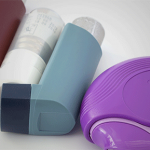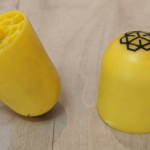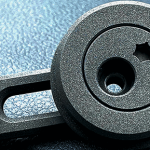- Home
- 3D Printing
- Using vacuum casting for overmoulding and insert moulding
Using vacuum casting for overmoulding and insert moulding
Overmoulding and insert moulding using Vacuum Casting
Vacuum casting is an invaluable process for prototyping and low volume production. It is commonly utilised during most phases of product development projects across a diverse range of industries. This article does not describe the features and benefits of vacuum casting in general (we have covered that topic previously) but instead it focuses on using vacuum casting for overmoulding and insert moulding. If small volumes are required, vacuum casting is extremely quick and cost-effective compared with commissioning aluminium soft tooling for injection moulding.
What is the difference between overmoulding and insert moulding?
With overmoulding, a second material is added to a component by injection moulding, hence the term two-shot moulding. However, during the prototyping stages of a product development programme, vacuum casting is excellent for simulating overmoulding. In most cases, an elastomer is added to the component’s surface to improve grip, the feel of the product in the hand, or aesthetics. There are other reasons for using overmoulding, as we will discuss below.
Note that true overmoulding usually takes place in a single specialised injection mould tool, or sometimes two separate tools for small quantities. But overmoulding with vacuum casting always requires the use of two silicone rubber tools.
In contrast, insert moulding involves placing small parts in the tool cavity, then moulding the plastic component around the inserts so they become integral to it. With prototyping, vacuum casting simulates insert moulding extremely well. Typically, threaded features are insert moulded but, as we will see below, the technique has other applications as well.
Overmoulding with vacuum casting
Overmoulding with vacuum casting simulates parts that will be two-shot injection moulded once they are in full production. A major benefit of vacuum casting in polyurethane (PU) resin is the wide range of materials that can be simulated – from soft elastomers through to glass-filled nylon. In addition, almost any colour can be produced.
Customers usually ask for a rigid grade to be overmoulded with a soft grade to simulate overmoulding with a thermoplastic elastomer (TPE). Less often, we use vacuum casting to overmould one relatively rigid grade of PU with another relatively rigid grade, perhaps in a different colour, or we use a coloured PU resin to overmould a clear PU casting.
Example applications include soft-feel grips on tactile products such as hairbrushes or handheld controllers. It is also a popular process when developing medical devices, drug delivery devices, consumer goods and automotive trim. Because both materials are grades of PU and the overmoulding is carried out before the primary moulding has cured fully, the bond between the two materials is very strong, resulting in a part that is suitable for use in handling trials.
Seal of approval
Another application for which overmoulding is ideal is the manufacture of integral seals or gaskets. Depending on the component’s requirements, thin sections can be cast in soft grades of PU to create very compliant seals for preventing leakage of liquids or dusts/powders. This type of seal can be useful for prototypes destined for functional testing. Furthermore, if overmoulded seals are used instead of liquid sealants, prototype components can be more easily disassembled and reassembled during testing.
The grades of polyurethane we use for overmoulding seals are generally resistant to acids, bases, oils and fuels. Nevertheless, we recommend customers check the material compatibility with us first.
What can be overmoulded with vacuum casting?
The best results are achieved when overmoulding a PU casting. However, we can also overmould plastic or metal parts that have been CNC machined, as well as modified production parts. Material compatibility is important for ensuring a good bond, so check with us first.
It is also possible to overmoulded SLA or DLP 3D printed parts, as these are non-porous. Parts produced using SLS, FDM or PolyJet do not work so well because the porosity can cause problems with outgassing and distortion, both when the silicone mould is being made and during the vacuum casting stage.
Excellent results are achieved if we start by using SLA to 3D print two masters; one with external geometry that simulates the finished part without the overmoulding, and the second with geometry that simulates that part with the overmoulding. These 3D printed parts are then hand-finished and prepared for use as masters when casting the silicone rubber moulds. One of these moulds is then used for casting the part without the overmoulding, then that cast part is overmoulded in the second mould.
Insert moulding with vacuum casting
We typically use insert moulding for equipping a part with bought-in parts such as threaded inserts or electrical contacts, or parts we have CNC machined in-house when it is critical to have features with tight tolerances. Where multiple inserts are required, we can CNC machine a fixture to ensure they are located accurately relative to each other and the mould cavity.
Aside from providing threads for fastening parts together, inserts can be plain bushings or have tightly-toleranced bores for installing rolling element bearings. Electrical contacts are another frequently requested type of insert.
If a product requires a clear aperture that is also sealed, the clear part can be readily insert-moulded to create a robust, sealed joint. The best bond/seal is achieved when the clear part is cast in a clear PU resin.
Other applications for insert moulding are wide-ranging, depending on the part’s required function and the designer’s imagination! Be aware, however, that with plastic inserts it is important to consider material compatibility if a good bond is to be achieved.
Vacuum casting versus PolyJet (Connex 3)
We are fortunate to have both vacuum casting and PolyJet 3D printing in-house. As a result, our detailed understanding of both processes means we can give unbiased advice about which would be best for any given project. The choice will depend on many factors, including the material properties required, size, quantities, timescales, finishes, and whether inserts need to be insert-moulded or can be installed afterwards.
Overmoulding and insert moulding for production parts
So far, we have discussed the use of vacuum casting for overmoulding and insert moulding during product development. However, such is the versatility of the process that it can also be used for low-volume production parts.
Vacuum cast PU has material properties that are suitable for many ‘real world’ products. It is isotropic, non-porous, tough, tear-resistant, UV-resistant, water-resistant and heat resistant. Some grades are fire-retardant. Remember, also, that PU resins available in a wide range of grades, from hard to soft and clear or coloured, and almost any surface finish can be reproduced.
Applications for overmoulding and insert moulding with production parts vary enormously, but vacuum casting lends itself very well to organic shapes that can be 3D printed for use as masters for making moulds. For example, 3D scanning enables a person’s hands, feet or head to be scanned, so we can make products that are truly personalised for the perfect fit. As with prototyping, the limit tends to be the designer’s imagination!
Talk to us
If you need overmoulded or insert-moulded vacuum cast parts, or just want to find out more about the processes, talk to us on 01763 249760.





